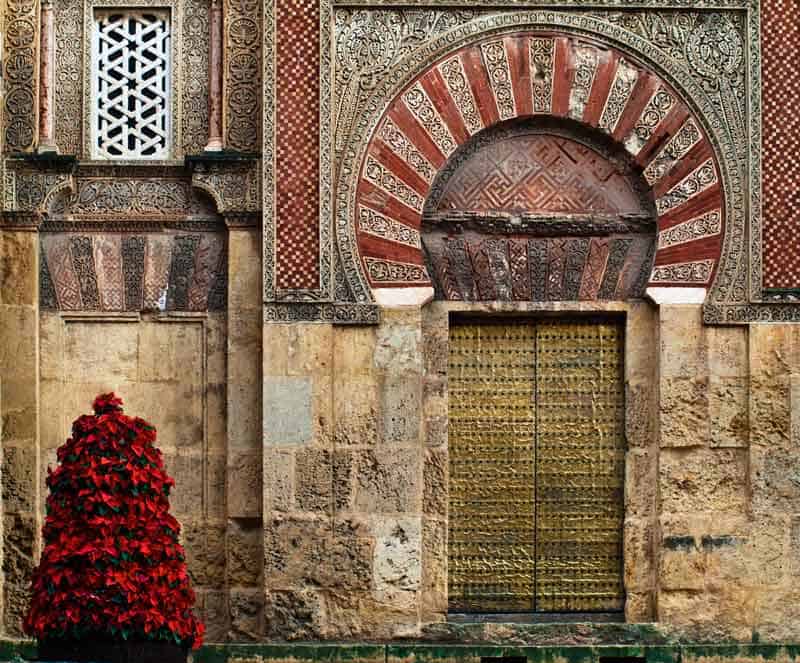Córdoba is an Andalusian city located on the banks of the Guadalquivir River. Its historic centre was declared a World Heritage Site by Unesco in 1994. Study visits in Cordoba would include monuments as impressive as the Mosque-Cathedral and the Alcazar de los Reyes Católicos.
1. Mosque-Cathedral of Córdoba
The Mosque-Cathedral is the flagship monument of the city and a must see in any study visits in Cordoba. It is currently declared a Site of Cultural Interest and it is also one of the most visited tourist areas in the country. It is considered the first of the 12 Treasures of Spain.
Visiting this impressive monument is a symbol of respect and unity. The history of different cultures and traditions converge in its architecture. The traveler must stop to contemplate the monumental complex and it is highly recommended to take a walk around the exterior of the entire monument. Here is where it is possible to see the different porticos that are located on the sides of the facade. But without a doubt, the most amazing part of this ancient religious building is its interior full of marble, jasper and granite columns.
2. Alcazar de los Reyes Católicos
The Alcazar de los Reyes Católicos is an impressive fortress that catches the travelers eye for its great amount of fused architectural contrasts. These give the monumental complex elegance and majesty. Study visits in Cordoba will see the different rooms of the Alcazar. Students can contemplate architecture, furniture and other elements of great cultural and historical interest that enhance the importance of the Alcazar of Córdoba. Some of the rooms give way to patios with exotic and beautiful flowers, aromatic herbs and leafy trees. The Mudéjar style strikes for its beauty. And when you arrive at the gardens you can contemplate with great admiration how the murmur of the water that runs through the canals and pools refreshes the atmosphere.
3. Torre de Calahorra and Roman bridge
The Torre de Calahorra is a fortress of Islamic origin conceived as an entrance and protection of the Roman Bridge of Cordoba. It is a Historic-Artistic Site since 1931, together with the Roman bridge and the bridge door. Later on, 1954 was the year for its renovation and restoration. The tower belongs now to the Dialogue of Cultures. Study visits in Cordoba will enjoy its new audio-visual museum with audio-guides. This will give the students a whole more organic and accurate sense of history.
4. Casa Sefarad
The Casa Sefarad is a place that transports the traveller to the past. It aims to keep alive the Jewish legacy. Something that study visits to Cordoba will surely appreciate and benefit from. Casa Sefarad is located in the Jewish quarter a few meters from the synagogue. The building dates from the fourteenth century.
Each of the rooms of the house shows some elements of the Jewish culture and tradition. All the rooms surround a central patio where there is a well and in which during the summer evenings it is possible to listen to musicians playing traditional Jewish instruments.
5. Cordoban streets and patios
Study visits to Cordoba are much more than a tour through houses and museums. Cordoba is full of colours and life and you can enjoy both features during a streetwalk. Walking through the streets of the city of Cordoba is truly pleasant. White walls full of flowers give life to its cobbled streets that invite the traveller to enter an enigmatic labyrinth.
6. Botanical Garden
The Royal Botanical Garden of Cordoba was an initiative of a group of teachers from the University of Cordoba and therefore a great destiny for any study visits in Cordoba. The botanical garden is about 5.5 hectares in which you can enjoy a variety of plants and flowers.
7. Palacio Viana
The Palace of the Marquises of Viana is a palace-museum that was declared an Asset of Cultural Interest in the city in 1981. It is located in the neighbourhood of Santa Marina. The history of the palace tells us that the Marquises of Villaseca owned the palace, and then, in 1901, the Marquises of Viana acquired it. Inside students can see different rooms: the Gallery of the Tiles, Gallery of the Legs, Hall of the Arts, Mosaic Room, Hall of the Coffered, Hall of the signatures, Tobias Hall, Goya Hall. Besides, the patios show a great diversity of flowers and plants.
Cordoba is a city of medieval favour. Not only because of its monuments, but because of its layout and habits. Study visits to Cordoba will enjoy a time travel as well as a very actual sip of what Spain has to offer. Visit Iberinbound for more ideas on destinys and things to do in this beautiful city and others.

